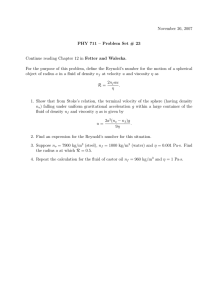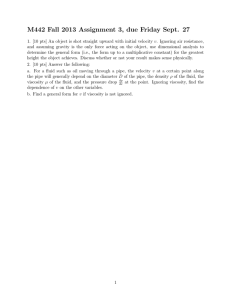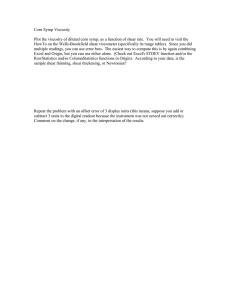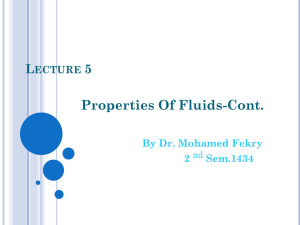MFGT 242: Flow Analysis Chapter 3: Stress and Strain in Fluid Mechanics
advertisement
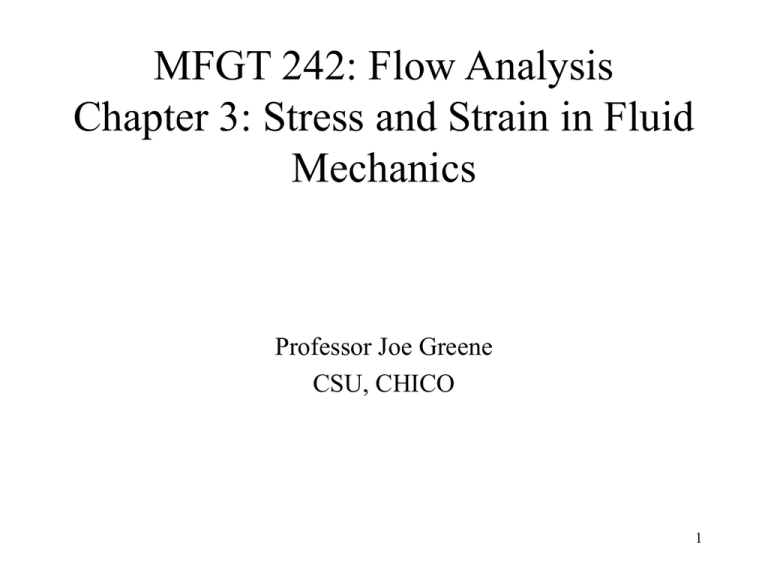
MFGT 242: Flow Analysis Chapter 3: Stress and Strain in Fluid Mechanics Professor Joe Greene CSU, CHICO 1 Types of Polymers • • • • Stress in Fluids Rate of Strain Tensor Compressible and Incompressible Fluids Newtonian and Non-Newtonian Fluids 2 General Concepts • Fluid – A substance that will deform continuously when subjected to a tangential or shear force. • Water skier skimming over the surface of a lake • Butter spread on a slice of bread – Various classes of fluids • Viscous liquids- resist movement by internal friction – Newtonian fluids: viscosity is constant, e.g., water, oil, vinegar » Viscosity is constant over a range of temperatures and stresses – Non-Newtonian fluids: viscosity is a function of temperature, shear rate, stress, pressure • Invicid fluids- no viscous resistance, e.g., gases – Polymers are viscous Non-Netonian liquids in the melt state and elastic solids in the solid state 3 Stresses, Pressure, Velocity, and Basic Laws • Stresses: force per unit area – Normal Stress: Acts perpendicularly to the surface: F/A • Extension • Compression Cross Sectional A Area A A F F – Shear Stress, : Acts tangentially to the surface: F/A • Very important when studying viscous fluids • For a given rate of deformation, measured by the time derivative d /dt of a small angle of deformation , the shear stress is directly proportional to the viscosity of the fluid F = µd /dt Deformed Shape 4 F Stress in Fluids • Flow of melt in injection molding involves deformation of the material due to forces applied by – Injection molding machine and the mold • Concept of stress allows us to consider the effect of forces on and within material • Stress is defined as force per unit area. Two types of forces – Body forces act on elements within the body (F/vol), e.g., gravity – Surface tractions act on the surface of the body (F/area), e.g., Press • Pressure inside a balloon from a gas what is usually normal to surface • Fig 3.13 zz zy zx 5 Some Greek Letters • Nu: • gamma: • rho: • delta: • tau: • epsilon: • eta: • mu: • Alpha: 6 Pressure • The stress in a fluid is called hydrostatic pressure and force per unit area acts normal to the element. pI – Stress tensor can be written • where p is the pressure, I is the unit tensor, and Tau is the stress tensor • In all hydrostatic problems, those involving fluids at rest, the fluid molecules are in a state of compression. – Example, • Balloon on a surface of water will have a diameter D0 • Balloon on the bottom of a pool of water will have a smaller diameter due to the downward gravitational weight of the water above it. • If the balloon is returned to the surface the original diameter, D0, will return 7 Pressure • For moving fluids, the normal stresses include both a pressure and extra stresses caused by the motion of the fluid – Gauge pressure- amount a certain pressure exceeds the atmosphere – Absolute pressure is gauge pressure plus atmospheric pressure • General motion of a fluid involves translation, deformation, and rotation. v – Translation is defined by velocity, v – Deformation and rotation depend upon the velocity gradient tensor – Velocity gradient measures the rate at which the material will v (v)T deform according to the following: – where the dagger is the transposed matirx – For injection molding the velocity gradient = shear rate in each cell dt dx x2 x1 2 1 d dv v v 8 Compressible and Incompressible Fluids • Principle of mass conservation t ( v) – where is the fluid density and v is the velocity • For injection molding, the density is constant (incompressible fluid density is constant) v 0 9 Velocity • Velocity is the rate of change of the position of a fluid particle with time – Having magnitude and direction. • In macroscopic treatment of fluids, you can ignore the change in velocity with position. • In microscopic treatment of fluids, it is essential to consider the variations with position. • Three fluxes that are based upon velocity and area, A – Volumetric flow rate, Q = u A – Mass flow rate, m = Q = u A – Momentum, (velocity times mass flow rate) M = m u = u2 A 10 Equations and Assumptions • Mass • Momentum • Energy v 0 Dt P g Dv Force = Pressure Force Viscous Force Gravity Force Dt C p q p v v DT Energy volume = Conduction Energy Compression Viscous Energy Dissipation 11 Basic Laws of Fluid Mechanics • Apply to conservation of Mass, Momentum, and Energy • In - Out = accumulation in a boundary or space Xin - Xout = X system • Applies to only a very selective properties of X – Energy – Momentum – Mass • Does not apply to some extensive properties – Volume – Temperature – Velocity 12 Physical Properties • Density – Liquids are dependent upon the temperature and pressure • Density of a fluid is defined as mass M 3 volume L – mass per unit volume, and – indicates the inertia or resistance to an accelerating force. • Liquid – Dependent upon nature of liquid molecules, less on T – Degrees °A.P.I. (American Petroleum Institute) are related to specific gravity, s, per: 141.5 A.P.I . s 131.5 – Water °A.P.I. = 10 with higher values for liquids that are less dense. – Crude oil °A.P.I. = 35, when density = 0.851 13 Density • For a given mass, density is inversely proportional to V • it follows that for moderate temperature ranges ( is constant) the density of most liquids is a linear function of Temperature • 0 is the density at reference T0 0 1 T T0 • Specific gravity of a fluid is the ratio of the density to the density of a reference fluid (water for liquids, air for gases) at standard conditions. (Caution when using air) s SC 14 Viscosity • Viscosity is defined as a fluid’s resistance to flow under an applied shear stress • Liquids are strongly dependent upon temperature Moving, u=V Y= h V y x Stationary, u=0 Y= 0 • The fluid is ideally confined in a small gap of thickness h between one plate that is stationary and another that is moving at a velocity, V • Velocity is v = (y/h)V • Shear stress is tangential Force per unit area, = F/A 15 Viscosity • Newtonian and Non-Newtonian Fluids – – – – – Need relationship for the stress tensor and the rate of strain tensor Need constitutive equation to relate stress and strain rate For injection molding it is the rate of strain tensor is shear rate For injection molding use power law model For Newtonian liquid use constant viscosity (m n 1 ) 16 Viscosity • For Newtonian fluids, Shear stress is proportional to velocity gradient. du V dy h • The proportional constant, , is called viscosity of the fluid and has dimensions M LT • Viscosity has units of Pa-s or poise (lbm/ft hr) or cP • Viscosity of a fluid may be determined by observing the pressure drop of a fluid when it flows at a known rate in a tube. 17 Viscosity Models • Models are needed to predict the viscosity over a range of shear rates. • Power Law Models (Moldflow First order) where m and n are constants. If m = , and n = 1, for a Newtonian fluid, m n 1 you get the Newtonian viscosity, . • For polymer melts n is between 0 and 1 and is the slope of the viscosity shear rate curve. • Power Law is the most common and basic form to represent the way in which viscosity changes with shear rate. • Power Law does a good job for shear rates in linear region of curve. • Power Law is limited at low shear and high shear rates 18 Viscosity • Kinematic viscosity, , is the ratio of viscosity and density • Viscosities of many liquids vary exponentially with temperature and are independent of pressure • where, T is absolute T, a and b • units are in centipoise, cP e T=200 a b lnT Ln T=300 T=400 0.01 0.1 1 Ln shear rate, 10 100 19
